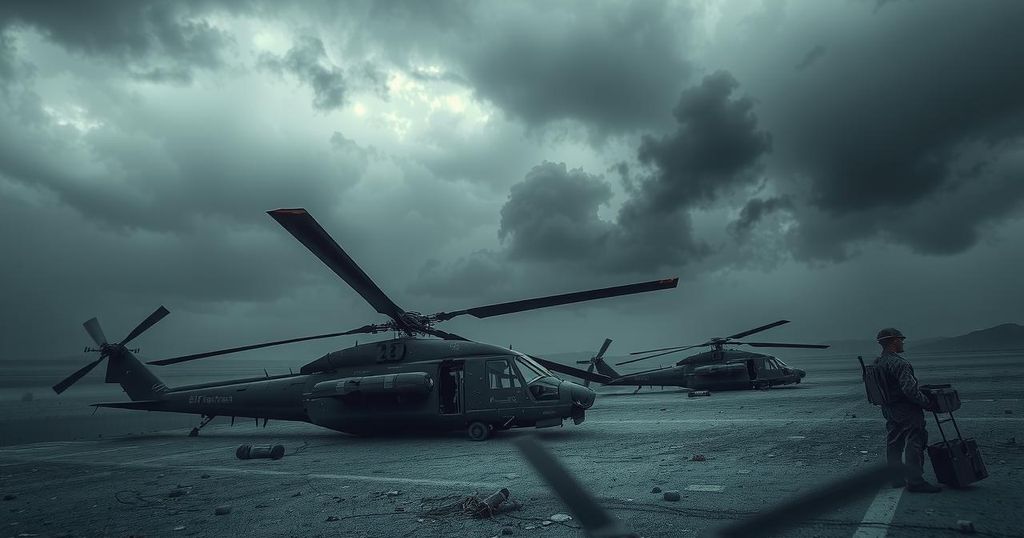Remembering the Battle of Mogadishu: A Turning Point in U.S. Military History

The 1993 Battle of Mogadishu marks a significant U.S. military engagement in Somalia, leading to the loss of 18 soldiers and two helicopters while attempting to assist in famine relief. The UN’s operation faced challenges from local warlords, culminating in a tragic encounter that reshaped U.S. foreign policy on peacekeeping efforts. Despite the historical significance, Somalia continues to confront ongoing strife and humanitarian challenges.
Somalia has a long history of food insecurity and famine, notably mirrored in the events of the 1993 Battle of Mogadishu. At that time, the United States intervened under the United Nations to address dire famine conditions, tragically resulting in the loss of two Black Hawk helicopters and 18 American soldiers.
The UN established the United Nations Operation in Somalia (UNOSOM) in 1992 to combat the civil war and mitigate hunger. Concurrently, the UN initiated ‘Operation Provide Relief’ to distribute food aid, which faced significant hurdles due to ongoing factional violence led by warlords. As the situation worsened, the UN adopted a stronger approach to assist those in need.
In December 1992, President George H.W. Bush authorized US troop deployment as part of Operation Restore Hope, facilitating humanitarian assistance. This led to the creation of the United Task Force (UNITAF) with a UN mandate allowing the use of force to maintain peace, transitioning to UNOSOM II by March 1993.
The mission faced resistance from the Somali National Alliance (SNA) headed by General Mohammad Farah Aidid, complicating UN efforts to safeguard aid deliveries. The expanded UNOSOM II mission sought to restore democracy, putting it at odds with Aidid’s faction. Despite calls for ceasefires, violence persisted, culminating in increased animosity.
A critical incident occurred in June 1993 when Pakistani UN troops were ambushed, escalating tensions between UN forces and Somali militias. Following clashes that resulted in civilian casualties, the purpose of UNOSOM II shifted towards apprehending General Aidid, marking a turning point in the conflict.
In August 1993, US forces, under Task Force Ranger, initiated Operation ‘Gothic Serpent’ aimed at capturing Aidid. On October 3, intelligence indicated a key meeting of Aidid was in progress at a Mogadishu hotel. An assault led by Major General William Garrison ensued, capturing SNA troops but failing to capture Aidid.
As US forces attempted to extract personnel from the hotel, they encountered fierce resistance from the SNA, resulting in the downing of two Black Hawk helicopters. The conflict at the crash sites revealed the intensity of the fighting, with significant casualties on both sides.
Ultimately, the operation was deemed a failure, with President Bill Clinton announcing the withdrawal of American troops. The incident resulted in 18 American fatalities and hundreds of Somali deaths, leading to a major shift in public sentiment regarding US involvement in international peacekeeping.
The Battle of Mogadishu is historically regarded as the bloodiest day for US military forces since the Vietnam War, significantly reshaping US foreign policy towards peacekeeping efforts. The US State Department acknowledged the profound challenges in balancing participation in global peacekeeping and the safety of American lives.
Despite this tragic consideration, the US Army characterizes the battle as a tactical success against a numerically superior enemy. Subsequent publications and films, such as Mark Bowden’s 1999 book and the 2001 movie adaptation of ‘Black Hawk Down,’ have kept the events in public consciousness.
Today, Somalia continues to grapple with ongoing conflict, and severe malnutrition issues persist among its population. According to the World Food Program, an alarming statistic indicates that 1.7 million children in Somalia may face acute malnutrition through December 2025.
This historical event serves as a reminder of the challenges the country faces, prompting renewed scrutiny of international approaches to aid and intervention in Somalia.
In summary, the Battle of Mogadishu marks a significant and tragic chapter in US military history, highlighting the complexities of international interventions in conflict zones. Despite initial humanitarian intentions, the mission resulted in significant casualties and prompted a reevaluation of US foreign policy concerning peacekeeping. Presently, the situation in Somalia remains dire, with ongoing conflict and humanitarian crises demanding urgent attention.
Original Source: www.eurasiantimes.com








